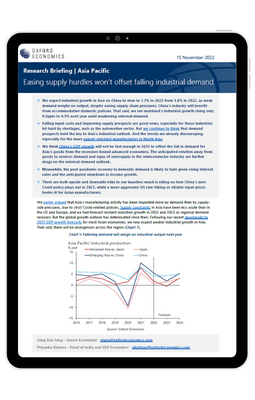Easing supply hurdles won’t offset falling industrial demand in APAC

We earlier argued that Asia’s manufacturing activity has been impacted more by demand than by supply-side pressures, due to strict Covid-related policies. Supply constraints in Asia have been less acute than in the US and Europe, and we had forecast resilient industrial growth in 2022 and 2023 as regional demand recovers. But the global growth outlook has deteriorated since then. Following our recent downgrade to 2023 GDP growth forecasts for most Asian economies, we now expect weaker industrial growth in Asia. That said, there will be divergences across the region.
What you will learn:
- We expect industrial growth in Asia ex-China to slow to 1.3% in 2023 from 3.8% in 2022, as weak demand weighs on output, despite easing supply chain pressures.
- Falling input costs and improving supply prospects are good news, especially for those industries hit hard by shortages, such as the automotive sector. But we continue to think that demand prospects hold the key to Asia’s industrial outlook. And the trends are already discouraging, especially for the more export-oriented manufacturers in North Asia.
- We think China’s GDP growth will not be fast enough in 2023 to offset the fall in demand for Asia’s goods from the recession-bound advanced economies. The anticipated rotation away from goods to services demand and signs of oversupply in the semiconductor industry are further drags on the external demand outlook.
Tags:
Related Resouces

Post
Airbnb’s Economic Contribution to APAC in 2024: GDP, Jobs, and Regional Impact
Airbnb's platform connects hosts across Asia Pacific (APAC) with travellers from around the world. Oxford Economics was commissioned by Airbnb to quantify its economic footprint in 10 APAC markets in 2024.
Find Out More
Post
Tariffs and tensions are reshaping city economies
Tariff policies, rising geopolitical tensions and unprecedented uncertainty are putting pressure on cities and regions across the world.
Find Out More
Post
What do the tariff letters mean for APAC and the China+1 strategy?
A tiered-tariff system effectively blurs the distinctions between goods made in China and those rerouted via regional supply chains, weakening the advantage of China+1 manufacturing.
Find Out More